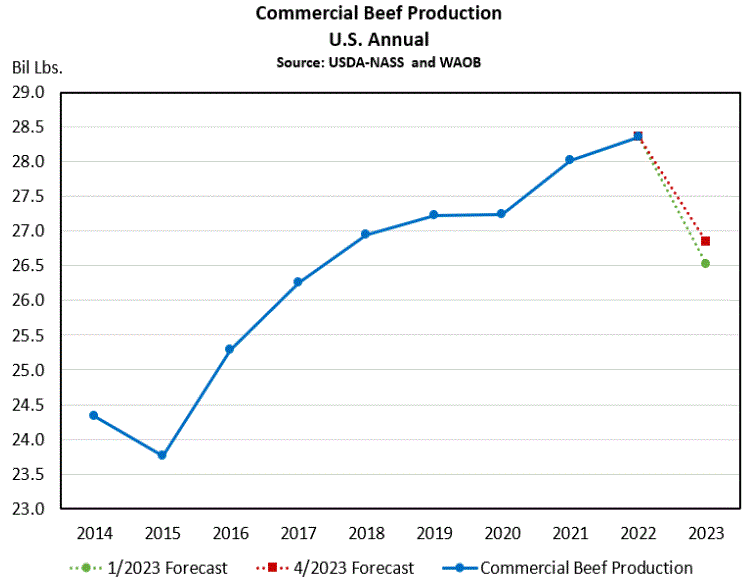James Mitchell, University of Arkansas
USDA's World Agricultural Outlook Board (WAOB) publishes the monthly World Agricultural Supply and Demand Estimates (WASDE) report. The report contains domestic and international supply and use forecasts for most crops and livestock products. USDA will update its monthly forecasts as more information about relevant supply and demand fundamentals becomes available. Tracking forecast updates and revisions from one report to the next provides a valuable perspective from USDA about what is impacting current and future crop and livestock production.
The graph at the top of this article shows commercial beef production for the current cattle cycle (blue line). The chart also includes beef production forecasts from the January (green line) and April (red line) WASDE reports. The most recent report for April forecasts 2023 beef production at 26.84 billion pounds, a 5.3% decline compared to 2022 production. Notice how the April forecast reflects an upward adjustment from USDA's earlier forecast in January. In the January WASDE, USDA forecasted 2023 beef production at 26.51 billion pounds, a 6.5% decline compared to last year's beef production. The forecast adjustment from January to April WASDE is 330 million pounds of commercial beef production. This adjustment changes the year-over-year percent decline in beef production from 6.5% to 5.3%. Either estimate, if realized, would be a significant decline in beef production
A natural question to ask is, why has USDA adjusted 2023 beef production upward? One explanation is to allow for the possibility of lingering drought impacts. Despite cattle inventories that have been in decline since 2019, last year's drought pushed 2022 beef production to record levels. In 2022, beef cow and heifer slaughter were both elevated because of drought. Beef cow slaughter finished last year at 11% higher, and heifer slaughter was 5% higher.
Beef cow and heifer slaughter have both started to moderate this year. Currently, heifer slaughter is running close to even with last year. Beef cow slaughter is 12% lower than last year. It is important to recognize regional differences in beef cow slaughter. Year-to-date beef cow slaughter in Region 6 (AR, LA, NM, OK, and TX) has declined by 14%. In Region 7 (IA, KS, MO, and NE), year-to-date beef cow slaughter is 1% higher than last year. Both regions have areas that are still in severe-exceptional drought. This becomes a bigger concern as we transition to late spring and early summer.
The consensus is that beef production will decline this year for the first time since 2015. The extent of that decline will depend on several factors, including drought. If USDA continues to adjust its 2023 beef production forecast upward, it will signal that drought is still impacting beef cow and heifer slaughter. This is not a critique of USDA's forecasts—just a recognition of the many unknowns concerning mother nature.















